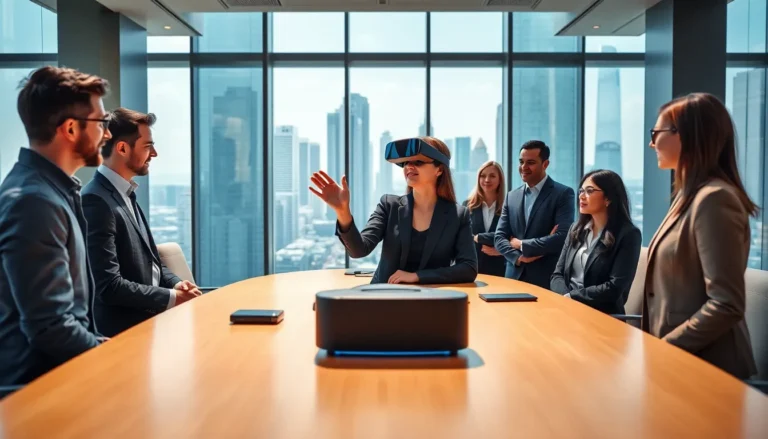Ever wondered what it’s like to walk through a museum while still in your pajamas? Or how about having a dinosaur munching on your living room coffee table? Welcome to the world of augmented reality (AR), where the virtual and real worlds collide in the most entertaining ways. Augmented reality development services are at the forefront of this tech revolution, helping businesses harness the power of AR to engage customers like never before. In this text, we’ll dive deep into the fascinating realm of AR, explore its applications, benefits, and much more. Buckle up, because the future is about to get a whole lot more exciting.
Table of Contents
ToggleUnderstanding Augmented Reality

Augmented Reality is not just a buzzword thrown around at tech conferences. It’s a sophisticated technology that overlays digital information, think images, videos, or sounds, onto the real world. Unlike virtual reality, which immerses users in a completely digital environment, AR enhances their existing environment with additional layers of information. This blend creates an interactive experience, bridging the gap between the physical and digital realms.
Imagine walking into a store and pointing your phone at a product. With AR, you might see customer reviews pop up or 3D models rotating beside the item, allowing a buyer to visualize how it would look in a home. AR technology is typically delivered through various devices, including smartphones, tablets, and specialized glasses, making it easily accessible to users.
Applications of Augmented Reality
AR isn’t just for fun and games: its applications span multiple industries, revolutionizing the way businesses operate and engage with their customers. Here are a few prominent applications in various sectors:
Retail
In retail, AR enhances the shopping experience by allowing consumers to visualize products in their own space before making a purchase. Brands like IKEA use AR apps to show customers how furniture will fit into their homes, no more awkwardly trying to squeeze a couch through your front door.
Healthcare
In healthcare, AR can enhance surgical procedures by providing surgeons with critical information superimposed on the patient during operations. This technology can improve accuracy and decrease recovery times, offering significant benefits to both patients and practitioners.
Education
Educational institutions leverage AR to create immersive learning experiences. Imagine history class featuring historical events that students can interact with firsthand. This type of learning makes information more engaging and easier to retain.
Gaming
The gaming industry has taken AR by storm, with popular titles like Pokémon Go encouraging players to explore the real world in pursuit of virtual creatures. This fusion creates a phenomenal experience that is both entertaining and engaging.
Benefits of Augmented Reality Development Services
Investing in augmented reality development services can yield numerous advantages:
Enhanced Customer Engagement
AR naturally draws users in. By combining entertainment with educational elements, businesses can retain customer attention longer than traditional marketing methods.
Increased Sales
As immersive experiences become commonplace, studies show that users are more likely to make a purchase after interacting with AR content. It’s the old adage: seeing is believing, especially when they can see it right in their living room.
Improved Brand Recognition
Establishing a brand as innovative and tech-savvy can significantly enhance its market presence. AR experiences tend to create memorable impressions, leading to increased brand loyalty and word-of-mouth marketing.
Cost Efficiency
Although the initial investment in AR can seem significant, the long-term benefits often offset the costs. From reducing the need for physical prototypes in product development to streamlining training with virtual simulations, AR can provide substantial savings over time.
Key Technologies in Augmented Reality
Augmented reality relies on various key technologies to create those seamless digital overlays. Here’s a closer look:
Computer Vision
Computer vision allows systems to interpret and understand visual data from the world around them. This technology is crucial for recognizing objects and environments, enabling the AR experience to function correctly.
Depth Tracking
Depth tracking helps devices understand distances within a space, which is vital for accurately placing virtual objects into the real world. Imagine your cat walking up to a virtual mouse, without depth tracking, that mouse would float in mid-air.
Projection
Projection technology takes AR a step further by displaying digital images directly onto surfaces. This technology can turn walls into interactive displays, creating limitless possibilities for brand experiences or entertainment.
Sensors
Sensors are the sensory organs of AR devices, gathering information about the user’s environment and interactions. This data allows for real-time responses, making the virtual experience more natural and intuitive.
Choosing the Right Augmented Reality Development Partner
Selecting the right development partner for AR projects is crucial. Here are some essential considerations:
Experience and Expertise
Look for a company with a proven track record in AR development. Reviewing their case studies can provide insight into their capabilities and creativity. You need a partner that not only understands the technology but also knows how to harness it effectively.
Customization Options
Every business has unique needs. A reliable partner will create tailored AR solutions rather than offer one-size-fits-all products. Ask about their process for understanding your requirements and how they plan to customize their services accordingly.
Support and Maintenance
AR technology evolves rapidly. Ensure your partner offers ongoing support and maintenance to keep your projects up-to-date and functioning reliably. This investment is vital for seamless user experiences.
The Future of Augmented Reality Development
The future of augmented reality development is bright and full of possibilities. As technology continues to advance, AR will blend even more seamlessly with our daily lives. Expect:
Greater Accessibility
As hardware improves and becomes more affordable, expect AR solutions to reach broader audiences. More people will have access to AR experiences, fostering creativity and innovation across various sectors.
Integration with AI
The integration of augmented reality with artificial intelligence will enhance user experiences, offering personalized and adaptive interactions. Imagine AR that knows your preferences and suggests tailored experiences just for you.
Expanded Applications
From remote work solutions to tourism and visualization in architecture, the future applications of AR are limitless. Society is on the brink of a technological renaissance, and AR will be a key player in this transformation.






